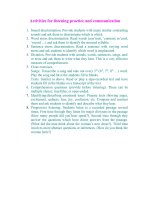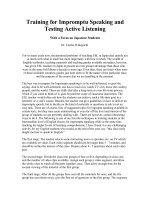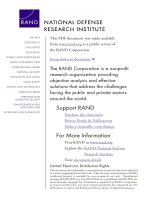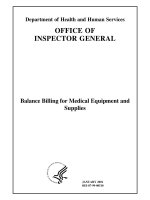Cost Allocation for Joint Products and By-Products
Bạn đang xem bản rút gọn của tài liệu. Xem và tải ngay bản đầy đủ của tài liệu tại đây (437.33 KB, 38 trang )
9
Cost Allocation for Joint Products
and By-Products
CHAPTER
LEARNING OBJECTIVES
After completing this chapter, you should be able to answer the following questions:
1
How are the outputs of a joint process classified?
2
At what point in a joint process are joint products identifiable?
3
What management decisions must be made before a joint process is begun?
4
How are joint costs allocated to products?
5
How are by-products treated in accounting systems?
6
How should not-for-profit organizations account for joint costs?
Buckhead
Beef
Company
INTRODUCING
uckhead Beef Company, headquartered in Atlanta,
is the largest provider of Certified Angus Beef
™
in
the United States. Howard Halpern cofounded the com-
pany in 1983, and the company currently has revenues
approaching $300 million.
Approximately 75 percent of Buckhead Beef’s sales
are select, choice, and prime grades of steak. The rest of
the company’s sales are pork, veal, lamb, game meats
and birds, provisions, deli meats, and seafood.
Buckhead’s truck fleet delivers products to customers
in the southeastern and northeastern states, and through
a distribution center in Puerto Rico, serves the Caribbean
market. In addition, however, through the company’s
steakhouse accounts, it achieves nationwide distribution.
Customers also include hotels, country clubs, upscale
retail outlets, and a small number of prestigious, well-
established grocery stores.
The company’s strength results, to some extent, from
combining the expertise of an in-house cut shop with the
efficiency of a large-scale distributor. Buckhead uses
energy-efficient equipment in its USDA inspected plant and
a state-of-the-art computerized bar coding system. This
system allows the company to track products from the time
they are processed at the packing plant to the time they
are aged, portion-cut, vacuum-packed, and delivered to
customers. The bar codes contain information on cost per
pound and historical data such as production line and
packaging date. Restaurant managers are particularly de-
lighted with this technology. Buckhead has an open-book
policy with its customers and sells on a true cost-plus basis.
Almost every company produces and sells more than one type of product. Al-
though companies may engage in multiple production processes to manufacture a
variety of products, they may also engage in a single process to simultaneously
generate various different outputs such as those of Buckhead Beef and its cus-
tomers (meat processors cut, segment, process, and package meats from a side of
beef). In a like manner, the refining of crude oil may produce gasoline, motor oil,
heating oil, and kerosene. A single process in which one product cannot be man-
ufactured without producing others is known as a joint process. Such processes
are common in the extractive, agricultural, food, and chemical industries. The costs
incurred for materials, labor, and overhead during a joint process are referred to
as the joint cost of the production process.
This chapter discusses joint processes, their related product outputs, and the
accounting treatment of joint cost. Outputs of a joint process are classified based
on their revenue-generating ability, and joint cost is allocated only to the primary
products of a joint process, using either a physical or monetary measure. Although
joint cost allocations are necessary to determine financial statement valuations, such
allocations should not be used in internal decision making.
1
Joint costs may also be incurred in service businesses and not-for-profit orga-
nizations. Such costs in these organizations are often for advertisements that pub-
licize different product lines or locations, or ads for different purposes, such as
public service information and requests for donations. Joint costs of not-for-profit
firms are covered in the last section of this chapter.
SOURCE
: Adapted from Bob Swientek, “A Cut Above,”
Prepared Foods
(October 1998), Rising Stars feature section. Reprinted with permission of Cahners Business
Information.
343
B
joint process
joint cost
1
Sometimes, correct pricing of a product depends on knowledge of the full cost of making the product, particularly when
contractual agreements require cost-plus pricing. Joint cost allocation is also necessary to the valuation of products, estimation
of product line profitability, and (in some cases) determination of product selling price.
Part 2 Systems and Methods of Product Costing
344
OUTPUTS OF A JOINT PROCESS
A joint process simultaneously produces more than one product line. The product
categories resulting from a joint process that have a sales value are referred to as
(1) joint products, (2) by-products, and (3) scrap. Joint products are the primary
outputs of a joint process; each joint product individually has substantial revenue-
generating ability. Joint products are the primary reason management undertakes
the production process yielding them. These products are also called primary prod-
ucts, main products, or coproducts.
Joint products do not necessarily have to be totally different products; the de-
finition of joint products has been extended to include similar products of differ-
ing quality that result from the same process. For example, when an oil refinery
processes petroleum into gasoline, the outputs will all have been derived from pe-
troleum, but different grades will have more octane and other characteristics based
on the extent and types of additional processing.
In contrast, by-products and scrap are incidental outputs of a joint process.
Both are salable, but their sales values alone would not be sufficient for manage-
ment to justify undertaking the joint process. For example, donut hole cutouts are
a by-product of the donut-making process. Scrap may be generated in the setup
stage. Contractors may tear out old fixtures, cupboards, etc., in remodeling a home.
Such items are often resold to other contractors.
2
By-products are viewed as having a higher sales value than scrap. A final out-
put from a joint process is waste, which is a residual output that has no sales
value. A normal amount of waste may create a production cost that cannot be
avoided in some industries. Alternatively, many companies have learned either to
minimize their production waste by changing their processing techniques or to re-
classify waste as a by-product or scrap through selling it to generate some mini-
mal amount of revenue.
A company may change a product classification over time because of changes
in technology, consumer demand, or ecological factors. Some products originally
classified as by-products are reclassified as joint products, whereas some joint prod-
ucts are reduced to the by-product category. Even products originally viewed as
scrap or waste may be upgraded to a joint product status. Years ago, for exam-
ple, the sawdust and chips produced in a lumber mill were considered waste and
discarded. These items are now processed further to produce particleboard used
in making inexpensive furniture. Therefore, depending on the company, sawdust
and chips may be considered a joint product or a by-product. Sometimes a by-
product will be accidentally discovered by good fortune. An interesting example
is found in the Internet revolution in the News Note on page 345.
Classification of joint process output is based on the judgment of company
managers, normally after considering the relative sales values of the outputs. Clas-
sifications are unique to each company engaged in the joint process. For exam-
ple, Lazy-K Ranch and Sterling Steers Ltd. each engage in the same joint produc-
tion process that produces three outputs: meats, bone, and hide. Lazy-K Ranch
classifies all three outputs as joint products, whereas Sterling Steers Ltd. classifies
meats and hide as joint products; bone is regarded as a by-product. These classi-
fications could have resulted from the fact that Lazy-K Ranch has the facilities to
process bone beyond the joint process, but Sterling Steers does not have such fa-
cilities. Further processing endows bone with a substantially higher sales value per
unit than selling bone as it exits the joint process.
How are the outputs of a joint
process classified?
joint product
1
by-product
scrap
waste
2
Recycling is a related issue. Now, about 75 percent of a car’s weight can be recycled. (Nissan is close to recycling 90 per-
cent.) Companies are working to similarly recycle waste of other products.
Chapter 9 Cost Allocation for Joint Products and By-Products
345
Can You Believe It?
NEWS NOTEGENERAL BUSINESS
E-commerce infomediaries are finding that as they mend
broken supply chains, one by-product is aggregated
purchase data that have never been available before.
Such is the case with Instill Corp., (till
.com) which provides an e-marketplace for the food-ser-
vices industry. Last week the company added a new ser-
vice called Instill Market Intelligence, which offers sub-
scriptions to the purchase data generated by buyers on
its systems.
Who is willing to pay its six-figure price tag? Some of the
world’s largest food manufacturers, including Bestfoods,
General Mills, Nestle, Perrier, Schreiber, and Tropicana.
These vendors have never had access to data about
the amount of product being purchased by restaurants
and other food-services outlets, such as hospitals. That’s
because sales in the industry are handled by thousands
of regional distributors, making it difficult to get an ac-
curate, aggregated view of purchase data—not just ship-
ment figures—across the manufacturer’s segments, cat-
egories, and products.
Access to that data will now let manufacturers, such
as Bestfoods, better manage production, plan new prod-
ucts, and market and sell existing products to the best-
suited buyers, according to T.C. Chatterjee, senior busi-
ness manager at Bestfoods.
“For the first time, we are able to support sales and
marketing efforts based on actual operator purchases,”
said Trevor Farrell, customer supply-chain manager at
Schreiber Foods Inc., another Instill subscriber.
“Using the data to standardize the industry is an ab-
solute must as a first step in a fragmented industry,” said
Forrester Research Inc. () ana-
lyst Bruce Temkin. “To sell the data back to manufactur-
ers is a big win. Over time, distributors will be forced to
operate in a more competitive environment, and you’ll
see more dynamic pricing.”
Food manufacturers have long had market-share data
from in-store supermarket sales via data providers such
as IRI or Neilsen. But in the food-services area, they have
relied on educated guesses as to how their products
stack up against competitors.
SOURCE
: Richard Karpinski, “Infomediary Repackages Sales Data for Vendors,”
Internetweek
(September 27, 1999), p. 8.
THE JOINT PROCESS
Joint products are typically produced in companies using mass production processes
and, thus, a process costing accounting method.
3
The outputs of a corn process-
ing plant, for example, may include corn on the cob and whole-kernel corn (joint
products), partial corn kernels (by-product) used for corn meal and grits, inferior
kernels (scrap) for sale to producers of animal food, and husks, corn silk, and cobs
(waste) that are discarded. Exhibit 9–1 illustrates the output of such a joint process.
The point at which joint process outputs are first identifiable as individual prod-
ucts is called the split-off point. A joint process may have one or more split-off
points, depending on the number and types of output produced. Output may be
sold at the split-off point if a market exists for products in that condition. Alter-
natively, some or all of the products may be processed further after exiting the
joint process.
Joint cost includes all costs incurred up to the split-off point for direct mate-
rial, direct labor, and overhead. Joint cost is allocated, at the split-off point, to only
the joint products because these products are the reason that management under-
took the production process. Allocation is necessary because of the cost principle.
Joint cost is a necessary and reasonable cost of producing the joint products and,
therefore, should be attached to them. Although necessary for valuation purposes
At what point in a joint process
are joint products identifiable?
2
3
For simplicity, Chapters 6 and 7 on process costing included examples of only single-product processes.
split-off point
for financial statements, the joint cost allocation to joint products is, however, not
relevant to decision making. Once the split-off point is reached, the joint cost has
already been incurred and is a sunk cost that cannot be changed regardless of
what future course of action is taken.
If any of the joint process outputs are processed further, additional costs after
split-off will be incurred. Any costs after split-off are assigned to the separate prod-
ucts for which those costs are incurred. Exhibit 9–2 depicts a joint process with
multiple split-off points and the allocation of costs to products. For simplicity,
all output of this joint process is considered primary output; there are no by-
products, scrap, or waste. Note that some of the output of Joint Process One (joint
Part 2 Systems and Methods of Product Costing
346
EXHIBIT 9–1
Illustration of Joint Process
Output
Raw Material
Input—
Fresh Corn
Joint Process—
Shucking and
Cleaning
Joint Process Outputs
Corn on the cob
(Joint Product)—
will be bagged and sold.
Whole kernels (Joint Product)—
will be added to water and
sugar, canned, and sold.
Partial kernels (By-product)—
will be ground to make corn
meal or grits and sold.
Husks, corn silk, and cobs
(Waste)—
will be discarded.
Inferior kernels (Scrap)—
will be sold to manufacturers
of animal food.
sunk cost
products B and C) becomes part of the direct material for Joint Process Two. The
joint cost allocations will follow products B and C into Joint Process Two for ac-
counting purposes, but these allocated costs should not be used in making deci-
sions about further processing in that department or in Department Four. Such de-
cisions should be made only after considering whether the expected additional
revenues from further processing are greater than the expected additional costs of
further processing.
Chapter 9 Cost Allocation for Joint Products and By-Products
347
EXHIBIT 9–2
Model of a Joint Process
Product A is warehoused or sold.
Product C is warehoused or sold.
Incur DM, DL, and OH costs
for joint products.
Department One
JOINT PROCESS ONE
Product A is separately
processed further; additional
costs of DM, DL, and OH are
totally assignable to Product A.
Department Two
PRODUCT A PROCESSING
Incur DM, DL, and OH costs
for joint products B and C.
Department Three
JOINT PROCESS TWO
PRODUCT B and C PROCESSING
Product B is warehoused or sold
at split-off point.
Product C is separately
processed further; costs of
DM, DL, and OH are
totally assignable only to
Product C.
Department Four
PRODUCT C PROCESSING
Split-off point; joint products A, B,
and C are produced. Allocate costs
of Joint Process One to joint
products A, B, and C.
Split-off point; allocate
costs of Joint Process Two
to joint products B and C.
Part 2 Systems and Methods of Product Costing
348
MANAGEMENT DECISIONS REGARDING JOINT PROCESSES
Certain decisions need to be made by company managers before committing re-
sources to a joint production process. First, total expected revenues from the
sale of the joint process output must be estimated and compared to total ex-
pected processing costs of the output. If the revenues are expected to exceed
the costs, management must then consider other potential costs. Because the
joint process results in a “basket” of products, managers must be aware that
some of the joint process output may require additional processing to make it
salable. Once joint process costs have been incurred, they become sunk costs
regardless of whether the output is salable at the end of the joint process or at
what amount. Thus, management must consider total joint costs plus expected
separate processing and/or selling costs incurred at or after the end of the joint
process in making the decision about whether to commit resources to the joint
process.
If total anticipated revenues from the “basket” of products exceed the antici-
pated joint and separate costs, the second management decision must be made.
Managers must compare the net income from this use of resources to that which
would be provided by all other alternative uses of company resources. If joint
process net income were greater than would be provided by other uses, manage-
ment would decide that this joint production process is the best use of capacity
and would begin production.
The next two decisions are made at split-off. The third decision is to deter-
mine how the joint process output is to be classified. Some output will be primary;
other output will be considered to be by-product, scrap, or waste. This classifica-
tion decision is necessary for the joint cost to be allocated, because joint cost is
only assigned to joint products. However, before allocation, joint cost may be re-
duced by the value of the by-products and scrap. Determination of by-product and
scrap value is discussed later in the chapter.
The fourth decision is the most complex. Management must decide whether
any (or all) of the joint process output will be sold at split-off or whether it will
be processed further. If primary products are marketable at split-off, further pro-
cessing should only be undertaken if the value added to the product, as reflected
by the incremental revenue, exceeds the incremental cost. If a primary product is
not marketable at split-off, additional costs must be incurred to make that product
marketable. For nonprimary output, management must also estimate whether the
incremental revenue from additional processing will exceed additional processing
cost. If there is no net benefit, the nonmarketable output should be disposed of
without further processing after the split-off point.
To illustrate a further-processing decision, assume that a whole turkey has a
selling price of $0.18 per pound at split-off, but the minimum selling price for
turkey parts after further processing is $0.23 per pound. If the additional process-
ing cost is less than $0.05 per pound, the $0.05 incremental revenue ($0.23 Ϫ
$0.18) exceeds the incremental cost, and additional processing should occur. Note
that the joint cost is not used in this decision process. The joint cost is a sunk cost
after it has been incurred, and the only relevant items in the decision to process
further are the incremental revenue and incremental cost.
Exhibit 9–3 presents the four management decision points in a joint pro-
duction process. In making decisions at any potential point of sale, managers
must have a valid estimate of the selling price of each type of joint process out-
put. Expected selling prices should be based on both cost and market factors. In
the long run, assuming that demand exists, the selling prices and volumes of
products must be sufficient to cover their total costs. However, immediate eco-
nomic influences on setting selling prices, such as competitors’ prices and con-
sumers’ sensitivity to price changes, cannot be ignored when estimating selling
prices and forecasting revenues.
What management decisions
must be made before a joint
process is begun?
3
Chapter 9 Cost Allocation for Joint Products and By-Products
349
EXHIBIT 9–3
Decision Points in a Joint Production Process
Do not produce
Do not produce
Determine best use at split-off
Sell at split-off
YES
NO
NO
Begin production and incur costs
for materials, labor, and overhead
Allocate joint cost
YES
SPLIT-OFF POINT
Revenues >
expenses for basket
of goods?
NO
YES
YES
NO
Joint Product?
YES
NO
NO
Marketable?
(1)
(2)
(3)
(4)
Best use of
facilities?
Incremental
profit after addi-
tional processing >
zero after
split-off?
Are
added revenues
after additional
processing >
additional
costs?
Incur additional costs
Sell
Part 2 Systems and Methods of Product Costing
350
Melted wax can be made into
scented or unscented candles
as well as into candles of differ-
ent sizes and shapes, with or
without a container. The cost of
getting the wax to this stage is
a joint cost that should be allo-
cated among the types of prod-
ucts to be manufactured.
ALLOCATION OF JOINT COST
Delectable Edibles Company is used to demonstrate alternative methods of allo-
cating joint processing cost. Because the consumer market for large portions of
large farm animals is limited, Delectable Edibles processes sides of beef into three
distinct primary products during a joint process: steaks, roasts, and ground meat.
(The remaining parts are considered by-products.) All joint products can be sold
at split-off. Alternatively, each beef product can be processed further, which will
create additional separate costs for the products. Steaks can be processed further
to produce steak sandwiches; roasts can be processed further to make special cuts;
and ground meat can be processed further to be used as part of a sausage mix-
ture. Certain marketing and disposal costs for advertising, commissions, and trans-
portation are incurred regardless of when the products are sold. Assumed infor-
mation on Delectable Edibles’ processing operations and joint products for October
2000 is presented in Exhibit 9–4.
Physical Measure Allocation
An easy, objective way to prorate joint cost at the split-off point is through the use of
a physical measure. Physical measurement allocation uses a common physical
How are joint costs allocated
to products?
4
Joint processing cost for period: $5,400,000
(1) (2) (3) (4) (5) (6)
Sales Price Selling Cost per Separate Cost Final Sales
Joint Tons of per Ton Ton Regardless per Ton if Price
Products Production at Split-Off of When Sold Processed Further per Ton
Steaks 3,800 $2,800 $200 $100 $3,200
Roasts 2,400 1,800 100 100 2,100
Ground 2,800 1,200 50 60 1,500
EXHIBIT 9–4
Basic Joint Cost Information
physical measurement
allocation
characteristic of the joint products as the proration base. All joint products must
be measurable by the same characteristic, such as
• tons of ore in the mining industry,
• linear board feet in the lumber milling industry,
• barrels of oil in the petroleum refining industry,
• tons of meat, bone, and hide in the meat packing or processing industry, or
• number of computer chips in the semiconductor industry.
Using physical measurement allocation, Delectable Edibles’ $5,400,000 of joint
cost is assigned as shown in Exhibit 9–5. For Delectable Edibles, physical mea-
surement allocation would assign a cost of approximately $600 ($5,400,000 Ϭ 9,000
tons) per ton of beef, regardless of type.
Physical measurement allocation treats each unit of output as equally desirable
and assigns the same per-unit cost to each. Also, unlike monetary measures, phys-
ical measures provide an unchanging yardstick of output.
4
A ton of output pro-
duced from a process 10 years ago is the same measurement as a ton produced
from that process today. Physical measures are useful in allocating joint cost to
products that have extremely unstable selling prices. These measures are also nec-
essary in rate-regulated industries that use cost to determine selling prices. For ex-
ample, assume that a rate-regulated company has the right to set selling price at
20 percent above cost. It is circular logic to allocate joint cost based on selling
prices that were set based on cost to produce the output.
A major disadvantage of allocating joint cost based on a physical measure is
that the method ignores the revenue-generating ability of individual joint products.
Products that weigh the most or that are produced in the largest quantity will re-
ceive the highest proportion of joint cost allocation—regardless of their ability to
bear that cost when they are sold. In the case of Delectable Edibles, each ton of
ground has been assigned a cost of $600. However, computations will demonstrate
that ground generates the lowest gross profit of the three joint products and yet
is being assigned the same joint cost per ton as the more desirable steaks and
roasts.
Monetary Measure Allocation
All commonly used allocation methods employ a process of proration. Because of
the simplicity of the physical measure allocation process, a detailed proration
Chapter 9 Cost Allocation for Joint Products and By-Products
351
Cost per Physical Measure ϭ Total Joint Cost Ϭ Total Units of Physical Measurement
ϭ $5,400,000 Ϭ 9,000 tons ϭ $600
Joint Cost Total
Product per Ton per Ton Allocated Cost
Steaks 3,800 $600 $2,280,000
Roasts 2,400 600 1,440,000
Ground 2,800 600 1,680,000
Total 9,000 $5,400,000
EXHIBIT 9–5
Joint Cost Allocation Based on
Physical Measurement
4
There are occasional exceptions to the belief that physical measures provide an unchanging yardstick of output. To illustrate,
many grocery products have been downsized in recent years. For example, coffee was formerly sold in one-pound containers;
now it is customarily sold in 13-ounce packages.
scheme was unnecessary. However, the following steps can be used to prorate
joint cost to joint products in the more complex monetary measure allocations:
1. Choose a monetary allocation base.
2. List the values that comprise the base for each joint product.
3. Sum the values in step 2 to obtain a total value for the list.
4. Divide each individual value in step 2 by the total in step 3 to obtain a nu-
merical proportion for each value. The sum of these proportions should total
1.00 or 100 percent.
5
5. Multiply the joint cost by each proportion to obtain the amount to be allocated
to each product.
6. Divide the prorated joint cost for each product by the number of equivalent
units of production for each product to obtain a cost per EUP for valuation
purposes.
The primary benefit of monetary measure allocations over physical measure
allocations is that the former recognizes the relative ability of each product to
generate a profit at sale.
6
A problem with monetary measure allocations is that
the basis used is not constant or unchanging. Because of fluctuations in general
and specific price levels, a dollar’s worth of output today is different from a dol-
lar’s worth of output from the same process five years ago. However, accoun-
tants customarily ignore price level fluctuations when recording or processing
data; in effect, this particular flaw of monetary measures is not usually viewed
as significant.
Three of the many monetary measures that can be used to allocate joint cost
to primary output are presented in this text. These measures are sales value at
split-off, net realizable value at split-off, and approximated net realizable value
at split-off.
SALES VALUE AT SPLIT-OFF
The sales value at split-off allocation assigns joint cost to joint products based
solely on the relative sales values of the products at the split-off point. Thus, to
use this method, all joint products must be marketable at split-off. Exhibit 9–6
shows how Delectable Edibles’ joint cost is assigned to production using the sales
value at split-off allocation method. Under this method, the low selling price per
ton of ground, relative to the other joint products, results in a lower allocated cost
per ton than resulted from the physical measure allocation technique. This process
uses a weighting technique based on both quantity produced and selling price of
production.
Part 2 Systems and Methods of Product Costing
352
5
Using decimal fractions often requires rounding. Greater precision can be obtained by simply dividing each step 2 value by
the step 3 value, leaving the result in the calculator, and multiplying that resulting value by the total joint cost.
6
Monetary measures are more reflective of the primary reason a joint process is undertaken: profit. Physical base allocations
are sometimes of dubious value because they are based on the flawed assumption that all physical units are equally desirable.
sales value at split-off
allocation
Joint Selling Decimal Joint Amount Cost
Product Tons Price Revenue Fraction Cost Allocated per Ton
Steaks 3,800 $2,800 $10,640,000 0.58 $5,400,000 $3,132,000 $824.21
Roasts 2,400 1,800 4,320,000 0.24 5,400,000 1,296,000 540.00
Ground 2,800 1,200 3,360,000 0.18 5,400,000 972,000 347.14
Total 9,000 $18,320,000 1.00 $5,400,000
EXHIBIT 9–6
Joint Cost Allocation Based on
Sales Value at Split-Off
NET REALIZABLE VALUE AT SPLIT-OFF
The net realizable value at split-off allocation method assigns joint cost based
on the joint products’ proportional net realizable values at the point of split-off. Net
realizable value (NRV) is equal to product sales revenue at split-off minus any costs
necessary to prepare and dispose of the product. This method requires that all joint
products be marketable at the split-off point, and it considers the additional costs
that must be incurred at split-off to realize the estimated sales revenue. The costs at
split-off point for Delectable Edibles’ products are shown in the fourth column of
Exhibit 9–4. The net realizable value of each product is computed by subtracting the
cost at split-off from the selling price at split-off. The $5,400,000 joint cost is then
assigned based on each product’s relative proportion of total net realizable value
(Exhibit 9–7). This method provides an allocated product cost that considers the dis-
posal costs that would be necessitated if the product were to be sold at split-off.
APPROXIMATED NET REALIZABLE VALUE AT SPLIT-OFF
Often, some or all of the joint products are not salable at the split-off point. For these
products to be sold, additional processing must take place after split-off, causing ad-
ditional costs to be incurred. Because of this lack of marketability at split-off, neither
the sales value nor the net realizable value approach can be used. Approximated
net realizable value at split-off allocation requires that a simulated net realizable
value at the split-off point be calculated.
7
This approximated value is computed on
a per-product basis as final sales price minus incremental separate costs. Incremental
separate costs refers to all costs that are incurred between the split-off point and
the point of sale. The approximated net realizable values are then used to distrib-
ute joint cost proportionately. An underlying assumption of this method is that the
incremental revenue from further processing is equal to or greater than the incre-
mental cost of further processing and selling. Approximated net realizable values
at split-off are determined for each product processed by Delectable Edibles using
the information in Exhibit 9–4.
Final Separate Costs Approximated Net
Joint Selling Price per Ton Realizable Value at
Products per Ton after Split-Off Split-Off
Steaks $3,200 $300 $2,900
Roasts 2,100 200 1,900
Ground 1,500 110 1,390
Further processing should be undertaken only if the incremental revenues will ex-
ceed the incremental costs.
8
These computations are shown on the next page.
Chapter 9 Cost Allocation for Joint Products and By-Products
353
net realizable value at split-
off allocation
Unit Net Total Net
Joint Realizable Realizable Decimal Joint Amount Cost
Product Tons Value per Ton Value Fraction Cost Allocated per Ton
Steaks 3,800 $2,600 $ 9,880,000 0.57 $5,400,000 $3,078,000 $810.00
Roasts 2,400 1,700 4,080,000 0.24 5,400,000 1,296,000 540.00
Ground 2,800 1,150 3,220,000 0.19 5,400,000 1,026,000 366.43
Total 9,000 $17,180,000 1.00 $5,400,000
EXHIBIT 9–7
Joint Cost Allocation Based on
Net Realizable Value at Split-Off
approximated net
realizable value at split-
off allocation
incremental separate cost
7
Another name for this method is the “artificial net realizable value at split-off allocation.”
8
Because some products will not be processed further, the approximated NRV at split-off method sometimes cannot be used
by itself and is combined with the NRV at split-off method to form a hybrid method.
Final Sales Cost per Cost per
Joint Sales Price at Ton at Ton after
Products Price Split-Off Split-Off Split-Off
Steaks $3,200 $2,800 $200 $300
Roasts 2,100 1,800 100 200
Ground 1,500 1,200 50 110
Joint Incremental Incremental
Products Revenue Cost Difference
Steaks $400 $100 $300
Roasts 300 100 200
Ground 300 60 240
The previous information shows that Delectable Edibles will be better off if all of
the joint products are processed further than if they are sold at split-off. For all
products, the incremental revenues from further processing exceed the incremen-
tal costs beyond split-off. The same conclusion can be reached by comparing the
net realizable values at split-off with the approximated net realizable values at split-
off, as follows:
Approximated Net
Joint Net Realizable Realizable Value
Products Value at Split-Off at Split-Off Difference
Steaks $2,600 $2,900 $300
Roasts 1,700 1,900 200
Ground 1,150 1,390 240
The decisions made about further processing affect the values used to allocate
joint cost in the approximated net realizable sales value method. If one or more
products will not be processed further because it is uneconomical to do so, the
value base used for allocation of joint cost will be a mixture of actual and ap-
proximated net realizable values at split-off. Products that will not be processed
further will be valued at their actual net realizable values at split-off; products that
will be processed further are valued at approximated net realizable values at split-
off. However, using a mixed base is unnecessary in this case because all products
are to be processed further. Delectable Edibles’ $5,400,000 joint cost is allocated
among the products as shown in Exhibit 9–8.
Each of the physical and monetary measures discussed allocates a different
amount of joint cost to joint products and results in a different per-unit cost for
each product. Each method has advantages and disadvantages. For most companies,
approximated net realizable value at split-off provides the best joint cost assign-
ment. This method is the most flexible in that no requirements exist about similar
Part 2 Systems and Methods of Product Costing
354
Approximated
Joint Net Realizable Total Approximated Decimal Joint Amount Cost
Products Tons Value per Ton Net Realizable Value Fraction Cost Allocated per Ton
Steaks 3,800 $2,900 $11,020,000 0.57 $5,400,000 $3,078,000 $810.00
Roasts 2,400 1,900 4,560,000 0.23 5,400,000 1,242,000 517.50
Ground 2,800 1,390 3,892,000 0.20 5,400,000 1,080,000 385.71
Total 9,000 $19,472,000 1.00 $5,400,000
EXHIBIT 9–8
Joint Cost Allocation Based on
Approximated Net Realizable
Value at Split-Off
measurement bases (pounds, tons, etc.) or actual marketability at split-off. It is,
however, more complex than the other methods, because estimations must be
made about additional processing costs and potential future sales values.
The values obtained from the approximated net realizable value at split-off
allocation method are used to illustrate cost flows in a joint cost environment.
Delectable Edibles has four production departments: (1) Meat Processing, (2)
Steak Filleting Production (using selected cuts of steak), (3) Marinating Cuts Pro-
duction (using roasts), and (4) Sausage Production (using ground). Work per-
formed in each of the second, third, and fourth departments creates finished
products that have been further processed beyond the split-off point. All of the
rest of the production in the Meat Processing Department, referred to as First
Cuts, Roasts, and Ground, is sold immediately at the split-off point. Delectable
Edibles uses FIFO costing and had the following finished goods inventories at
the beginning of April:
Filet mignon 260 tons @ $900 per ton $234,000
Marinated cuts 280 tons @ $580 per ton 162,400
Sausage 300 tons @ $420 per ton 126,000
During April, the company incurred separate costs for Filets, Marinated Cuts, and
Sausage of $186,000, $122,000, and $83,406, respectively. All of the products started
into processing in April were also completed during that month. The company sold
the following quantities of products in April:
Sales Price Total Sales Price
Product Quantity per Ton (Cash)
First cut steaks 1,794 tons $2,800 $ 5,023,200
Roasts 1,160 tons 1,800 2,088,000
Ground 1,260 tons 1,200 1,512,000
Filet mignon 1,986 tons 3,400 6,752,400
Marinated cuts 1,220 tons 2,200 2,684,000
Sausage 1,500 tons 1,500 2,250,000
Totals 8,920 $20,309,600
The April 2000 journal entries for Delectable Edibles Company are shown in Ex-
hibit 9–9 on page 356. The ending balances of Delectable Edibles’ three finished
goods accounts are computed as follows:
TONS
Filets Marinated Cuts Sausage
Beginning inventory 260 280 300
Tons completed (assumed) 2,006 1,240 1,540
Tons available 2,266 1,520 1,840
Tons sold 1,986 1,220 1,500
Ending inventory 280 300 340
ϫ FIFO unit costs $ 902.72
a
$ 615.89
b
$ 439.87
c
EI valued at FIFO costs $252,762 $184,767 $149,556
a
($186,000 Ϭ 2,006 tons) ϩ $810.00 allocated joint cost ϭ $902.72
b
($122,000 Ϭ 1,240 tons) ϩ $517.50 allocated joint cost ϭ $615.89
c
($83,406 Ϭ 1,540 tons) ϩ $385.71 allocated joint cost ϭ $439.87 (rounded)
These ending inventory unit values represent approximate actual costs of production.
Prorating joint cost provides necessary inventory valuations for manufactur-
ing companies. However, the allocation process may be influenced by the net
realizable values of the other possible outputs of a joint process—by-products
and scrap.
Chapter 9 Cost Allocation for Joint Products and By-Products
355
Part 2 Systems and Methods of Product Costing
356
(1) Work in Process Inventory—Meat Processing 5,400,000
Supplies Inventory 185,714
Wages Payable 3,900,000
Manufacturing Overhead 1,314,286
To record joint process costs incurred in
April 2000; credit amounts are assumed.
(2) Work in Process Inventory—Filets 1,624,860
Work in Process Inventory—Marinated Cuts 641,700
Work in Process Inventory—Sausage 594,000
Work in Process Inventory—Meat Processing 2,860,560
To allocate some of the joint cost incurred in
Meat Processing to other departments for filleting,
marinating, and making sausage.
(3) Work in Process Inventory—Filets 186,000
Work in Process Inventory—Marinated Cuts 122,000
Work in Process Inventory—Sausage 83,406
Various accounts 391,406
To record separate costs for further processing
incurred in the Filets, Marinated Cuts, and
Sausage Production Departments.
(4) Finished Goods Inventory—First Cuts 1,453,140
Finished Goods Inventory—Roasts 600,300
Finished Goods Inventory—Ground 486,000
Finished Goods Inventory—Filets 1,810,860
Finished Goods Inventory—Marinated Cuts 763,700
Finished Goods Inventory—Sausage 677,400
Work in Process Inventory—Meat Processing 2,539,440
Work in Process Inventory—Filets 1,810,860
Work in Process Inventory—Marinating 763,700
Work in Process Inventory—Sausage 677,400
To transfer 9,000 tons of meats to finished goods
status: (1,794 tons of First Cuts ϫ $810.00),
(1,160 tons of Roasts ϫ $517.50), (1,260 tons of
Ground ϫ $385.714), (2,006 tons of Filets—
$1,624,860 ϩ $186,000), (1,240 tons of marinated
cuts—$641,700 ϩ $122,000), and (1,500 tons
of sausage—$594,000 ϩ $83,400).
(5) Cash 20,309,600
Sales 20,309,600
To record cash sales.
(6) Cost of Goods Sold 5,726,721
Finished Goods Inventory—First Cuts 1,453,140
Finished Goods Inventory—Roasts 600,300
Finished Goods Inventory—Ground 486,000
Finished Goods Inventory—Filets 1,792,098
Finished Goods Inventory—Marinated Cuts 741,333
Finished Goods Inventory—Sausage 653,850
To record cost of goods sold on a FIFO basis.
(7) Selling Expenses 1,132,000
Cash 1,132,000
To record selling expenses ($200 ϫ 3,780) ϩ
($100 ϫ 2,380) ϩ ($50 ϫ 2,760). (Actual costs
are assumed to equal estimated selling costs
shown in Exhibit 9–4.)
EXHIBIT 9–9
Journal Entries for April 2000









